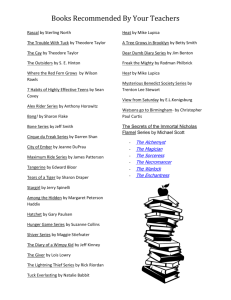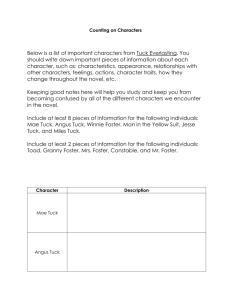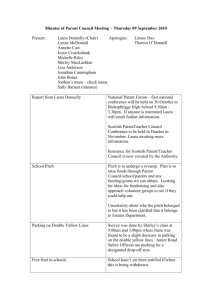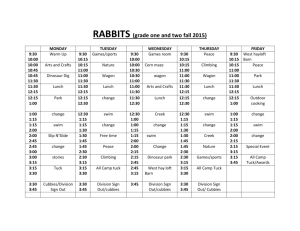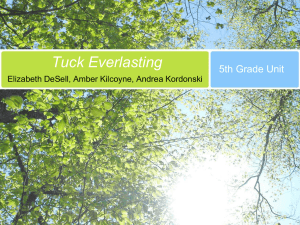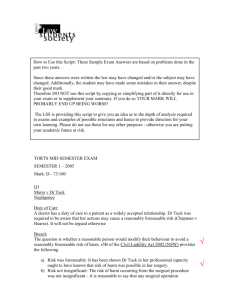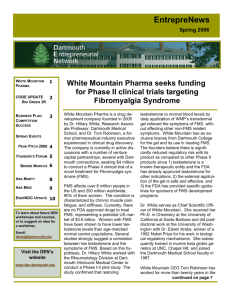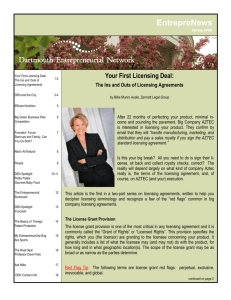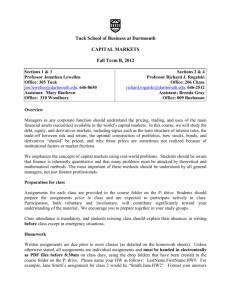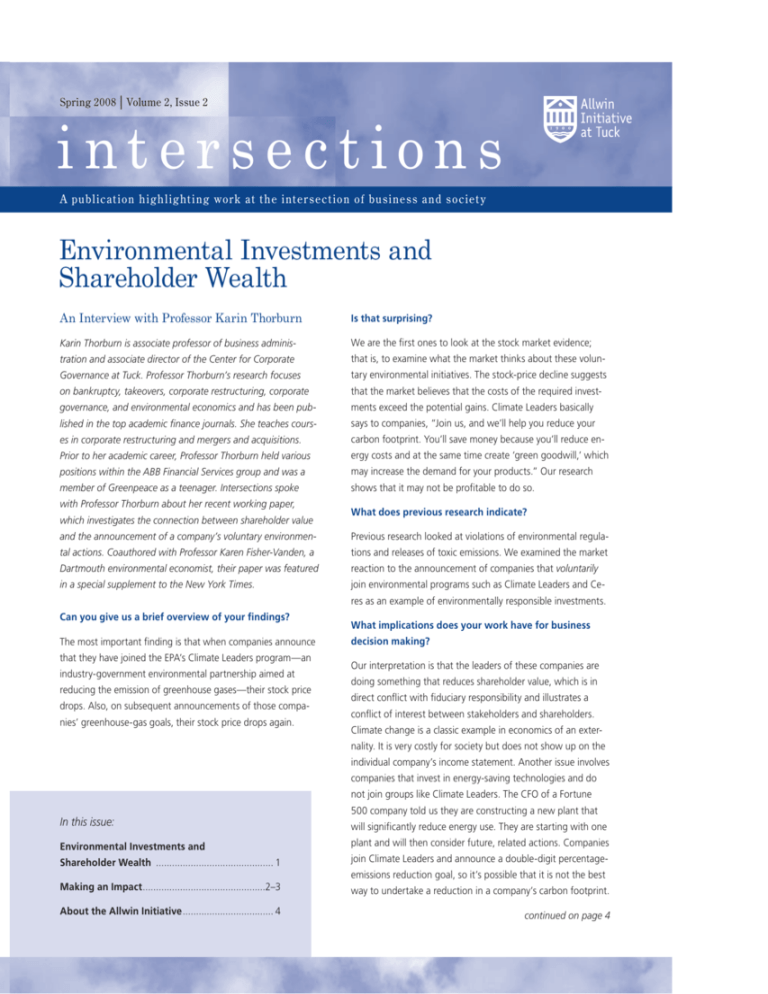
Spring 2008
| Volume 2, Issue 2
intersections
A p ub l i c a t i o n h i g h l i g ht i n g wo r k a t t he i nt e r s e c t i o n o f b u s i n e s s a nd s o c i e t y
Environmental Investments and
Shareholder Wealth
An Interview with Professor Karin Thorburn
Is that surprising?
Karin Thorburn is associate professor of business adminis-
We are the first ones to look at the stock market evidence;
tration and associate director of the Center for Corporate
that is, to examine what the market thinks about these volun-
Governance at Tuck. Professor Thorburn’s research focuses
tary environmental initiatives. The stock-price decline suggests
on bankruptcy, takeovers, corporate restructuring, corporate
that the market believes that the costs of the required invest-
governance, and environmental economics and has been pub-
ments exceed the potential gains. Climate Leaders basically
lished in the top academic finance journals. She teaches cours-
says to companies, “Join us, and we’ll help you reduce your
es in corporate restructuring and mergers and acquisitions.
carbon footprint. You’ll save money because you’ll reduce en-
Prior to her academic career, Professor Thorburn held various
ergy costs and at the same time create ‘green goodwill,’ which
positions within the ABB Financial Services group and was a
may increase the demand for your products.” Our research
member of Greenpeace as a teenager. Intersections spoke
shows that it may not be profitable to do so.
with Professor Thorburn about her recent working paper,
which investigates the connection between shareholder value
What does previous research indicate?
and the announcement of a company’s voluntary environmen-
Previous research looked at violations of environmental regula-
tal actions. Coauthored with Professor Karen Fisher-Vanden, a
tions and releases of toxic emissions. We examined the market
Dartmouth environmental economist, their paper was featured
reaction to the announcement of companies that voluntarily
in a special supplement to the New York Times.
join environmental programs such as Climate Leaders and Ceres as an example of environmentally responsible investments.
Can you give us a brief overview of your findings?
The most important finding is that when companies announce
that they have joined the EPA’s Climate Leaders program—an
industry-government environmental partnership aimed at
reducing the emission of greenhouse gases—their stock price
drops. Also, on subsequent announcements of those companies’ greenhouse-gas goals, their stock price drops again.
What implications does your work have for business
decision making?
Our interpretation is that the leaders of these companies are
doing something that reduces shareholder value, which is in
direct conflict with fiduciary responsibility and illustrates a
conflict of interest between stakeholders and shareholders.
Climate change is a classic example in economics of an externality. It is very costly for society but does not show up on the
individual company’s income statement. Another issue involves
companies that invest in energy-saving technologies and do
not join groups like Climate Leaders. The CFO of a Fortune
500 company told us they are constructing a new plant that
In this issue:
will significantly reduce energy use. They are starting with one
Environmental Investments and
plant and will then consider future, related actions. Companies
Shareholder Wealth ............................................ 1
join Climate Leaders and announce a double-digit percentageemissions reduction goal, so it’s possible that it is not the best
Making an Impact ..............................................2–3
way to undertake a reduction in a company’s carbon footprint.
About the Allwin Initiative .................................. 4
continued on page 4
Making an Impact
Oil & Water: Business Opportunities
to Fuel Our Future
The 2008 Business & Society Conference
with what we try to do at Tuck to help students create a personal leadership profile that’s sensitive to the environment but
at the same time aims at growth, productivity, and profitability
for their firms.” Ultimately, the conference did provide a direc-
It might seem an odd mix, but the pairing of oil and water
tion forward and clear action items that could indeed improve
makes sense when you consider that both resources are criti-
a company’s financial bottom line while addressing resource
cal to civilization and that it will take cooperation from all
and environmental issues.
sectors to protect them. The 2008 Business & Society Conference brought together more than 25 energy, water stewardship, and sustainability experts from around the globe. Over
three days, they discussed the economic and environmental
Transforming the Inner City:
Economic Development in Philadelphia
challenges and opportunities presented by these two vital
A Tuck GIVES Internship (Summer 2007)
resources. Considering the event drew more than 300 Tuck
The Philadelphia Industrial Development Corporation (PIDC) is
students—the largest number ever to attend a student-orga-
a private not-for-profit corporation charged with stimulating
nized conference at the school—the topic did indeed prove
economic development in the city of Philadelphia. It is the cus-
appealing.
todian for much of Philadelphia’s surplus city-owned industrial
land. PIDC provides financing and real estate services with the
In spite of foreboding assessments of dwindling supply, confer-
goal of transforming dormant parcels of land into sites for job-
ence chair Dave Adams T’08 says, “It is the belief of many that
creating enterprises.
over the next 30 years the issues and challenges created by
these two commodities will yield the greatest opportunities to
drive earnings, implement conservation programs, and enact
social good.” He’s talking triple bottom line—a new model
gaining momentum in the business world. It’s about pursuing
opportunities that are simultaneously (1) profitable, (2) socially
responsible, and (3) environmentally sustainable.
Participating conference experts were drawn from Fortune
Although the corporation sells its real estate holdings to developers, it does not just sell to the highest bidder. PIDC takes
into consideration the neighborhood benefits of a potential
development, particularly the number of jobs that might be
created. Since its founding in 1958, PIDC has contributed to
the completion of $16 billion in projects and the creation of
over 442,000 jobs. As a seller of real estate, it is imperative
that PIDC price parcels to ensure the best possible sale value.
500 companies, world-class consultant groups, developers,
After conducting an exhaustive study of real estate sales in
investment firms, and nonprofits. Panel topics included the
Philadelphia, I created an interactive database that will help
financial risk of climate change, clean-tech investing strategies,
PIDC be more successful in negotiating with potential devel-
sustainable water solutions in developing nations, and realizing
opers. The information provided by the database will help
significant cost efficiencies through water stewardship. In the
management devise more effective pricing strategies before
first keynote address, Matthew Simmons, chairman of Sim-
entering into sales negotiations. I also participated in several
mons & Company International, provided incisive insight into
interactions with potential developers, assisting in the analysis
the oil industry; in the second, John Brock, CEO of Coca-Cola
of proposals and creating a tool that will improve the corpora-
Enterprises, discussed his company’s corporate responsibility
tion’s ability to properly administer its leases.
program and its integral link to company strategy.
In his introduction to John Brock, Dean Paul Danos emphasized how proud Tuck is of the conference. “Its topics dovetail
2 Intersections Spring 2008
Intern: Michael Wilson T’08
Empowering Young Urban Talent
to Reach Their Potential
A Tuck GIVES Internship (Summer 2007)
will be creating a business plan for the project, benchmarking
with other corporate/NGO partnerships, and helping improve
the management of the cooperative itself to make the foodsecurity solution sustainable. Four team members traveled
Year Up is a one-year intensive training program that provides
to Nicaragua during spring break to begin gathering data by
urban young adults, ages 18 to 24, with a combination of
meeting with farmers in several mountain communities, the
hands-on skill development, college credits, and corporate
cooperative’s directors, and potential NGO partners.
apprenticeships. Since 2001, Year Up has graduated over 600
young adults, who earn, on average, $30,000 per year after
completing the program. Year Up currently serves more than
450 students a year at sites in Boston, Cambridge, Providence,
T’09 team: Alex Burgess, Lea Goryn Grunfeld, Bradley Lang,
Kristen Loureiro, Aaron Mihaly, and Anja Veckenstedt
Washington, D.C., and New York City. Having just completed a
Doing Well, Doing Good, and Having Fun
successful $19 million capital campaign, Year Up is looking to
Allwin Initiative Guest Speaker (Fall 2007)
expand nationally, with the goal of adding four new sites over
Gary Hirshberg, chairman, president, and “CE-Yo” of Stony-
the next three years.
field Farm, a New Hampshire-based manufacturer of organic
My summer internship involved working with CEO and
yogurt products, was among the guest speakers hosted by
Founder Gerald Chertavian on a due-diligence analysis of the
the Allwin Initiative this academic year. Hirshberg spoke to the
cities Year Up is considering for its new sites. It was a great
Dartmouth community about his success developing an orga-
learning experience to be able to take a project from its begin-
nization that combines doing well, doing good, and having
ning through problem definition, research, and analysis to the
fun. In growing Stonyfield Farm from seven cows to over $260
presentation at the end. As a result of my work this summer,
million in sales, Hirshberg demonstrated that it is possible to
the organization has focused its expansion efforts on two
build a for-profit enterprise that can successfully compete in
priority cities and has a framework for thinking about expan-
the national and global marketplace while being environmen-
sion, which will support good decision making going forward.
tally responsible. Stonyfield Farm’s commitment to quality,
The best reward for me is that startup in these two cities is
sustainable farming, employee well-being, environmental
underway, and Year Up is now that much closer to having a
responsibility, and profitability contributes to its status as the
national-level impact on the lives of urban young adults.
#3 yogurt brand in the United States and the largest organic
yogurt brand in the world. Encoding its mission statement
Intern: Nick Richardson T’08
into everything it does also contributes to Stonyfield Farm’s
ability to develop an emotional relationship with its customers,
Food Security Initiative in Central America
First-Year Project (Spring 2008)
allowing the organization to spend less of its annual revenues
on advertising (only one percent) and more of its revenues on
its products and the planet. As the first U.S. manufacturer to
Green Mountain Coffee Roasters (GMCR) is developing a pilot
offset 100 percent of its CO2 emissions, the first dairy producer
project in Nicaragua to address the problem of food security
to pay farmers for not using synthetic growth hormones, a
in the coffee-growing region. The region’s coffee farmers eat
donor of 10 percent of its profits to environmental causes,
well for eight to nine months of the year while they’re selling
and as of October 2007, a 100 percent organic food producer,
coffee but then suffer three to four “thin months” when food
Stonyfield Farm is a role model: truly a company that embodies
prices go up and they have no coffee income. GMCR plans
the phrase doing well by doing good.
to partner with a fair-trade coffee cooperative and an experienced international nongovernmental organization (NGO)
Student writer: Rachel Roth D’02, T’09
to create a sustainable solution to this issue. The Tuck team
Intersections Spring 2008 3
Environmental Investments
continued from page 1
That being the case, what might be the implications of this research for public
policy?
One implication of this research is that regulation of greenhouse gases might be called
for in the United States. I think about the Kyoto agreement. A number of countries
About the Allwin Initiative
agreed to a reduction in greenhouse-gas emissions, and each provided its own goals—
for Corporate Citizenship
how much they would cut back from a base level. Europe began moving to calibrate the
An interconnected globe, shifting ideologies,
systems, while the U.S. chose not to regulate.
What future research questions do you have in mind?
There isn’t much work being done at the intersection of environmental studies and
and the changing role of governments
have made business a significant agent of
transformation. Business knowledge can
finance. We want to continue work in this area. One idea is to identify other voluntary
be applied to community needs and world
environmental initiatives. Another is to look more broadly at how green companies per-
issues. It can work across sectors to develop
form. We will give seminars and present the paper at academic conferences to get input
solutions. The opportunities are endless. The
on this work.
Allwin Initiative aims to prepare Tuck students
What’s important for MBA students to consider?
for decision making and leadership in this
This research raises questions on green goodwill and where we are today. Would marginal consumers shift consumption patterns and pay more? Where at the margin—even
increasingly complex, interconnected world. We
work to ensure that the changing issues at the
if you create green goodwill—do you use corporate resources? It comes back to regula-
intersection of business and society are a key
tion. If we as a society want companies to reduce their carbon footprints on a broad
component of our MBA education and a part of
scale, we need a policy change. For example, in Sweden, taxes on oil and gas are high,
Tuck’s broader scholarly activities.
so geothermal options are competitive for home heating. Maybe when oil becomes
more expensive in the United States, using geothermal energy may become a competitive alternative to oil. The City of Oslo, Norway, allows small electric cars to park for free
in its downtown area. There is something similar in California. You can use economic
Allwin Initiative for
Corporate Citizenship
incentives to encourage action. Maybe Tuck should reserve parking spaces for electric
Tuck School of Business at Dartmouth
cars and hybrids!
100 Tuck Hall
Hanover, NH 03755-9000 USA
tuck.allwin.initiative@dartmouth.edu
www.tuck.dartmouth.edu/initiative
© 2008 by the Trustees of Dartmouth College.
All rights reserved.
4 Intersections Spring 2008

